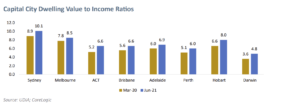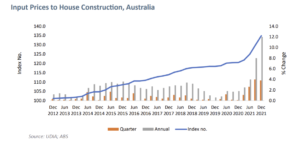Federal policy responses over the past two years ensured that the Australian economy through the COVID-19 pandemic remained resilient. Benchmarked against our global peers, the nation had a stronger post-pandemic recovery than many might have expected. Early focus on the housing and construction sector was instrumental in creating new jobs and investments across the development chain.
However, fast-forward to 2022 and otherwise accommodative policies are now blamed for the reverse. This being a slow delivery pipeline and a gradually rising deterioration of housing affordability and material shortages. Our nation’s capital cities rank among the least affordable in the world, and these hardships are spreading to regional markets.

The role of the development and construction (D&C) industry down-under cannot be understated, contributing to 9% of Australia’s GDP in 2021, with 11% of Australian jobs depending on the industry. So, fondness for revisionist history aside, we think it’s imperative to address these challenges both within the D&C sector and the broader macro context to better identify what is causing this mismatch.
Every day a developer wakes up and asks themselves two questions – can I get it profitably built and can I get it profitably sold? The latter is addressed to the consumer and the former to the contractor.
And the missing piece that determines how it all falls into place is our favourite ‘C’ word – CREDIT… but also our least favourite ‘C’ word – COST.
The contractor first with his least favourite C word. The rise in construction pricing has been broad-based, with the nation’s home-building sector seeing the House Construction Output Index soaring by 11.0% across the last twelve months, outstripping Non-Residential (+6.4% YoY), Other Residential (+5.6% YoY), and Heavy and Civil Engineering Construction (+5.6% YoY).

So onto our favourite C word – Credit. The non-bank space has been successful at offering credit to a sector that has been widely ignored by traditional lending institutions. The problem we have now is that in an environment of rapidly rising costs, lenders are reluctant to offer succinct numbers on project delivery costs, especially if it’s a multi year endeavour. So without a fixed build contract, how are we stacking up their feasibility and their credit lines? We get higher sales values, as this would imply reasonable LVRs (loan-to-value ratios) and, as long as we’re below that magical 2-digit number.
This is where one other C word comes in – Consumer, as well as their relationship to credit. Rising interest rates deteriorate affordability, dampening demand and the ability to access and pay for housing. Also worth considering is how falling home prices are equally disruptive, because the developer doesn’t know how profitably he’ll be able to sell. This goes back to LVRs and then the reasoning becomes circuitous.
So now that we’ve unpacked the matters at play, let’s get onto the silver lining. In all of this, credit channels have remained open for both developers and consumers. Federal and state policy reform is aimed at assisting homeownership and a slew of fin-tech start-ups are assisting with the same. Developers should be shopping around, as the right contract and the right credit partner can help with your cost expectations. Sometimes even shaving a few months from your project delivery makes a world of difference, as does a few basis points here and there. So to my developer comrades out there, for Feasibility’s sake, do shop around.






